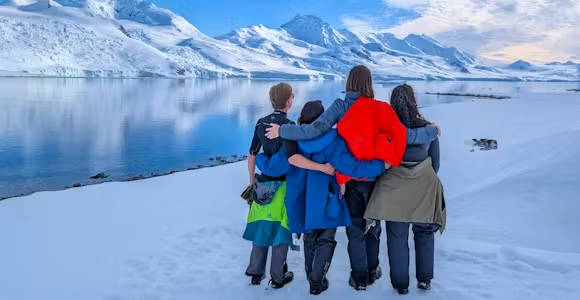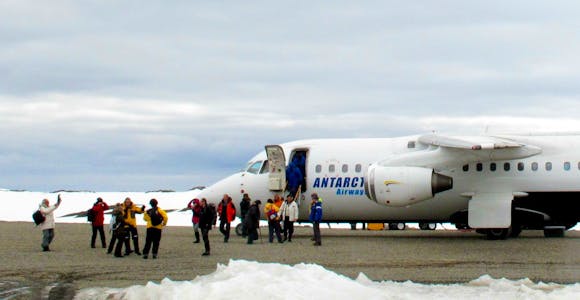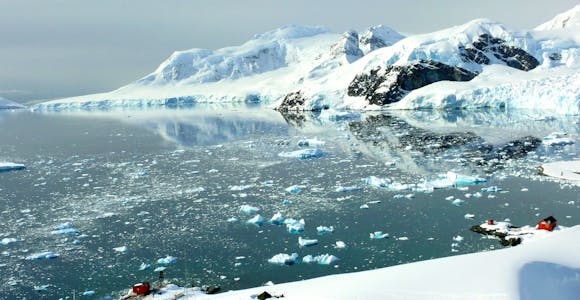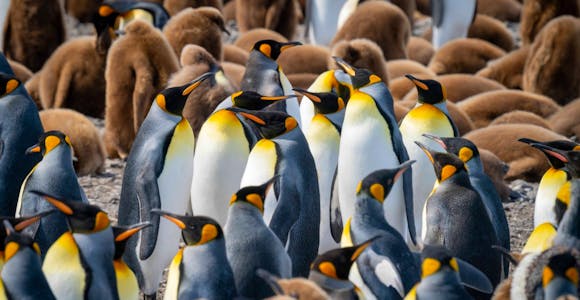
When to go to Antarctica
Choosing when to go to Antarctica is a key part of planning a cruise, with each month of the season offering a different side of the continent.
Discover MoreAntarctica’s interior is like nowhere on Earth. While the Antarctic Peninsula teems with life, this is a place of empty landscapes where the silence is only broken by the polar wind, barring a few isolated spots where emperor penguins make their lives.
Feeling humbled by the endless the white wilderness is what the interior is all about, and only a handful of travellers step foot here every year. The logistical challenges of safely operating in such an extreme remote environment means that the cost of entry is high. But with a wide range of activities and comfort levels to be explored, you definitely no longer need to be leading an expedition to reach the prize of the South Pole.

Price Match Promise - We’ll match any price you find elsewhere for the same trip
As much a place of the imagination as a real spot on the map, reaching the South Pole is the ultimate achievement for any visitor to Antarctica. There is no sledging for lonely weeks like the earliest explorers to get here. Instead, it’s a five hour flight from your base camp in the interior, cruising over the endless white of the polar plateau until you finally reach 90° South.
Visitors stay overnight in a tent camp, giving you a chance to acclimatise to the 11,000ft (3300m) altitude of the plateau, and plenty of time to take celebratory photos at both the Geographic and Ceremonial Poles. As you traverse every line of longitude in a few steps, whichever way you look from here you’ll be pointing north.

The emperor penguin is one of the true icons of Antarctica, as well as its most elusive. Rarely seen on all but a tiny handful of cruises to the Weddell Sea, travellers must head south into the interior for a glimpse of their private world. The emperor penguin colonies you’ll find at Gould Bay and Akta Bay are breathtaking, leaving you unsure if you’re in a David Attenborough documentary or the March of the Penguins movie.
The penguins can only be reached by specially adapted aircraft, with visitors staying in a field camp around a mile (1.6 km) away to avoid disturbing them. Getting to spend an extended period of time observing these beautiful birds and their fluffy chicks is an unforgettable privilege.

The Antarctic Interior is almost impossibly remote. Camps here are so deep in the polar wilderness that their nearest neighbours are the astronauts high orbiting above in the International Space Station.
Adventurers who make it here can hike to lonely mountain outcrops that gaze down over ice fields that stretch to the horizon, visit hidden glacial lakes that few people have ever seen, or just marvel at the silence that lingers when you know that even your footprints will soon be swept away by the wind, leaving no evidence that anyone ever stood here before.
Visitors should prepare to be humbled and inspired in equal measure by the immensity of the landscapes on offer.

One need not experience the Antarctic Interior as a passive visitor: the luxury basecamps all offer a variety of different ways to explore the vast landscapes that surround the adventurous traveller.
Closer to camp, the hard snow is perfect for experiencing on a fat bike, while it’s possible to head further afield by cross-country skiing, on a skidoo or hiking through the emptiness to natural features such as unusual glacial lakes, ice caves or just mountain viewpoints to look out over the unearthly vistas.
For more experienced travellers who want to , there is the option for rock climbing or ice climbing, allowing you to take on your own particular polar challenge by conquering your own private frozen peak.

Antarctica offers the opportunity to climb some of the most extraordinary mountains on the planet.
The biggest prize of all is Mount Vinson in the Ellsworth Mountains: the highest peak in Antarctica at 16,050 ft (4892 m), and the most elusive peak in the Seven Summits Challenge. Ascents typically take 5–9 days depending on the weather conditions, starting from a remote field camp on the Branscomb Glacier.
The second most popular peak to climb is Mount Sidley, Antarctica’s highest volcano at 14,058 ft (4285 m), which has still only been climbed by a handful of mountaineers.

This is the greatest factor: the way in which the expedition is equipped, the way in which every difficulty is foreseen, and precautions taken for meeting or avoiding it. Victory awaits him who has everything in order.
Roald Amundsen on reaching the South Pole in 1911
There are no regular scheduled flights to the South Pole or Antarctic Interior. Only specialist polar logistic companies can safely operate flights here.
There are two gateway cities for trips to the South Pole and Antarctic Interior. From Punta Arenas in Chile (airport code PUQ), it is a 4½ hour flight to Union Glacier Camp. From Cape Town in South Africa (airport code CPT) it is a five hour flight to Wolf’s Fang Runway, which serves Whichaway Camp.
Within Antarctica, the South Pole and other destinations are served by ski-equipped Havilland DHC-6 Twin Otters or DC-3 Basler BT-67 planes.

The South Pole and Antarctic Interior offer some of the most exclusive (and certainly the most remote) accommodation on the planet.
Guests stay in luxury camps, sleeping in tents or pods. It’s a far cry from the days of the earliest explorers: expect snug accommodation, chefs preparing fresh food and even hot showers.
All camps operate on a strict leave no trace principle to minimise any environmental impacts.

The Antarctic Interior is one of the most extreme environments on Earth, and the visitor season is much more truncated than the traditional Antarctic Peninsula cruising season.
Trips here operate from mid-November to late January, in order to take advantage of the 24 hours of daylight during the austral summer, as well as the most consistently calm weather.
During these months, the average temperatures at the camps in the Antarctic Interior range from -12F to 30F (-24C -1C), although wind chill can cut into these temperatures dramatically. In the earlier part of the season, temperatures as low at -22F (-30C) aren’t unknown.

In a world where adventures abound, reaching the South Pole will always stand out as a cut above the rest. Time and again, it's this expedition which tops the bucket list of anyone fascinated by the end of the world.
When you’re visiting somewhere as remote as the Antarctic Interior, safety is paramount. Our partners have decades of experience successfully operating in the Antarctic Interior, including providing direct logistical support to national Antarctic scientific programmes.
This in-depth knowledge of polar operating conditions is used to build detailed risk management protocols and contingency plans that keep all visitors safe and comfortable. From the best outdoor guides in the business and on-site doctors, to advanced monitoring to the most detailed weather forecasting and the practicalities of maintaining an air bridge to Antarctica, everything is put at the service of guest safety.

Monitoring Antarctic weather
The logistical complexity of organising these trips -enormous distances, lack of services and extreme weather - is baffling. From the tip of South America to Union Glacier Camp is further than London to St. Petersburg or Los Angeles to Chicago. A large transport plane, the size of a Boeing 767, capable of covering this distance and suited to off-strip landings, is chartered for the duration of the Antarctic summer. Even within Antarctica distances are enormous, requiring air travel and fuel caching. Two or more twin engine ski aircraft are chartered for the season, for flights beyond Union Glacier Camp.
Being Antarctica, there are no inherent facilities here, so the operation is entirely self-supporting, flying in all of the equipment, fuel, and food needed from South America. Read Swoop's guide to Antarctic costs
The Antarctic travel season runs through the Austral summer (November through January) when the weather is at its best. The Antarctic interior is a cold desert climate - dry and windy.
Average mid-season temperatures at Union Glacier Camp and Whichaway Camp can range from 10F to 25F (-12C to -4C). On a sunny, windless day it can feel quite warm, but when hit with a true polar gust you'll be glad to have as many warm layers on as possible. Temperatures in early November can fall as low as -22F (-30C).
The South Pole: Temperatures here rarely climb above -13F (-25C). With windchill, it can feel like -40F (-40C).
The snow around Union Glacier camp is generally firm and fine for walking. This is also true of the South Pole and the Emperor penguin camp. The snow on Mt Vinson is generally quite firm and good for climbing with crampons. Skis are primarily for recreational use, and visitors do not have to ski as a pre-requisite to the interior. However, if you are keen on a ski ascent and are an experienced ski-mountaineer, then this can be arranged.
The itineraries on our website are an example meant to give an idea of what these trips might entail. However, the weather is the ultimate arbiter of what is possible. As a result, flight schedules are flexible and you should expect and prepare for possible delays.
Poor weather days at Union Glacier Camp provide opportunities for talks and skills sessions on Antarctic themes such as navigation, crevasse rescue, cold weather injury, communications and meteorology. Ad-hoc talks by visiting scientists, expedition teams and other guest-experts are always popular. Games, jigsaw puzzles and DVD's provide diversion. Or you can delve into the library of Antarctic books and light novels.
Unless you're going on the Camp with Emperor Penguins trip (in which case you'll see plenty of emperor penguins), then you're not likely to see much in the way of wildlife. The Antarctic interior is an icy desert. Whilst majestic in its proportions, it is devoid of the vegetation necessary to support wildlife.

Choosing when to go to Antarctica is a key part of planning a cruise, with each month of the season offering a different side of the continent.
Discover More
Around 1 in 12 visitors to Antarctica arrive by air – this our guide on everything you need to know about flying to the White Continent.
Discover More
The Peninsula is the classic way to experience Antarctica. Some of the best wildlife and most dramatic scenery can be found in this part of the Frozen Continent.
Discover More
A jewel in Antarctica's crown, South Georgia is one of the world's great wildlife destinations: the Serengeti of the Southern Ocean
Discover MoreWe'll spend some time listening to your aspirations, then discuss the kind of experience that might suit you.
Next we'll discuss the options, shortlist the best trips for you and present you our impartial recommendations.
We'll place a 24 hour hold on your preferred option - without obligation - whilst we talk through the details.
With over 100 years of Antarctic experience between us, we can help guide you to exactly the right trip for you.
1 888 970 4570

